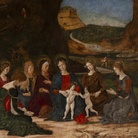Silvia Mariotti. Dawn on a Dark Sublime

Silvia Mariotti. Dawn on a Dark Sublime
From 14 Novembre 2015 to 10 Febbraio 2016
Venice
Place: A plus A Gallery
Address: San Marco 3073
Times: Tuesday to saturday 11am-06pm. Sunday by appointment
Responsibles: Aurora Fonda, Sandro Pignotti
Ticket price: free entrance
Telefono per informazioni: +39 041 2770466
E-Mail info: info@aplusa.it
Official site: http://www.aplusa.it
Opening the 14th November 2015 at 6.00 pm.
The Dawn On A Dark Sublime project by artist Silvia Mariotti investigates an extraordinary natural phenomenon characterized by a strong historical connotation – the artist has in fact chosen to photograph vertical caves, chasms, large sinkholes in Istria and Karst known as foibe.
These sinkholes are a controversial subject – both in the public debate and in the personal exhibition of Silvia Mariotti in which sublime notions of nature intertwine with historical thought.
Photographs, videos, sculptures and sound installations convey the visitor a double sublime horror: the magnificence of the depicted nature that touches our perception, but also intends to convey historical implications. The title is a reference to memory, to the process of remembering, to casting light on a nocturnal subject through artistic research – DAWN is in fact the dawning that gradually leads to light.
This is an unpublished work that is offered to the public for the first time at the A plus A gallery. It consists of fifteen works including sculptures, photographs, videos and sound installations resulting from the study that Silvia Mariotti has been conducting on this subject for more than two years.
Works that the artist has developed through fieldwork in the landscape itself, searching for caves that have been abandoned for decades and are known only to local people.
Illustrious predecessors have attempted similar endeavours – in 1861, Felix Nadar was the first that took a camera into the underground of Paris, beating his colleagues in the initiative to take photographs in the sewerage and catacombs of a major metropolis.
It was then that for the first time the lens was attributed with the ability to make discoveries and the art of photography was born – the photographic and sculptural project of Silvia Mariotti is just like the enterprise of Nadar – a sublime discovery.
In recent decades, the foibe have become a symbol of recent history of Italy and Istria. For the collective imagination, these caves, like Pandora’s box, seem to contain all the evils of the twentieth century.
They have become the catalyst of ethnic hatred, of war crimes against the Italians and the local population, of experience of exile and of a great trauma of the nation that originated in the period between the two world wars.
But these caves are also a natural phenomenon. The foibe do not tell only the history of Europe in the 20th century, but tell also a story of nature and geology spanning millennia and of a number of literary, psychological, theological, mythological and aesthetic suggestions.
When JULES VERNE, for example, visited the Istrian town of Pazin and the Pazinčica river that flows through the valley, he imagined a parallel reality within the hollow-earth, in which the protagonists of his famous adventure novel Journey to the Center of the Earth discovered in the center of the planet a world where there are underground seas and electric radiation, as if they belonged to the prehistory or to alien universes.
The exhibition of SILVIA Mariotti is not only a revisit of recent history, but it also aims to be a revelation of a unique natural phenomenon.
In the work of the Italian artist, all these meanings manifest themselves in the eyes of the visitor who learns to juggle with multiple levels of reading that can open to interpretation and that can broaden the horizons which are often limited by historical traumas.
The exhibited works require above all an individual look and memory of the visitor, because the dimension of memory is something that mainly concerns the individual. And exactly this is the magic of the sublime: although it concerns the intimate sphere it has the strength to open up the access to a more authentic view of nature and history.
SILVIA Mariotti was born in Fano in 1980. She lives and works in Milan. Photography is her main tool for artistic research of the habitat surrounding us, identifying the linkages between artificial and natural.
The photomechanic eye pauses on elusive atmospheres, anomalous elements or enigmatic situations; it strives to isolate the gaze from the clamor of life, stubbornly to slow down syncopated rhythm to grab those chips that – when considered individually – make up the fabric of existence, dotted with desires and longings, balances and contradictions, lights and shadows. In all her works, Silvia Mariotti tries to gather experience on places and people to better reflect the environmental and social situation in which we live.
The exhibition is curated by Aurora Fonda and Sandro Pignotti and accompanied by a catalog with texts by critics Paolo Fonda, Rebecca Moccia, Sandro Pignotti and Marta Verginella. The exhibition will remain open until the Day of Remembrance on February 10, 2016.
After the exhibition in Venice, Silvia Mariotti will, in the spring of 2016, carry out a project for Villa Manin at Passariano extending her research to the events of the First World War.
The exhibition has been technically supported by Pixartprinting
The Dawn On A Dark Sublime project by artist Silvia Mariotti investigates an extraordinary natural phenomenon characterized by a strong historical connotation – the artist has in fact chosen to photograph vertical caves, chasms, large sinkholes in Istria and Karst known as foibe.
These sinkholes are a controversial subject – both in the public debate and in the personal exhibition of Silvia Mariotti in which sublime notions of nature intertwine with historical thought.
Photographs, videos, sculptures and sound installations convey the visitor a double sublime horror: the magnificence of the depicted nature that touches our perception, but also intends to convey historical implications. The title is a reference to memory, to the process of remembering, to casting light on a nocturnal subject through artistic research – DAWN is in fact the dawning that gradually leads to light.
This is an unpublished work that is offered to the public for the first time at the A plus A gallery. It consists of fifteen works including sculptures, photographs, videos and sound installations resulting from the study that Silvia Mariotti has been conducting on this subject for more than two years.
Works that the artist has developed through fieldwork in the landscape itself, searching for caves that have been abandoned for decades and are known only to local people.
Illustrious predecessors have attempted similar endeavours – in 1861, Felix Nadar was the first that took a camera into the underground of Paris, beating his colleagues in the initiative to take photographs in the sewerage and catacombs of a major metropolis.
It was then that for the first time the lens was attributed with the ability to make discoveries and the art of photography was born – the photographic and sculptural project of Silvia Mariotti is just like the enterprise of Nadar – a sublime discovery.
In recent decades, the foibe have become a symbol of recent history of Italy and Istria. For the collective imagination, these caves, like Pandora’s box, seem to contain all the evils of the twentieth century.
They have become the catalyst of ethnic hatred, of war crimes against the Italians and the local population, of experience of exile and of a great trauma of the nation that originated in the period between the two world wars.
But these caves are also a natural phenomenon. The foibe do not tell only the history of Europe in the 20th century, but tell also a story of nature and geology spanning millennia and of a number of literary, psychological, theological, mythological and aesthetic suggestions.
When JULES VERNE, for example, visited the Istrian town of Pazin and the Pazinčica river that flows through the valley, he imagined a parallel reality within the hollow-earth, in which the protagonists of his famous adventure novel Journey to the Center of the Earth discovered in the center of the planet a world where there are underground seas and electric radiation, as if they belonged to the prehistory or to alien universes.
The exhibition of SILVIA Mariotti is not only a revisit of recent history, but it also aims to be a revelation of a unique natural phenomenon.
In the work of the Italian artist, all these meanings manifest themselves in the eyes of the visitor who learns to juggle with multiple levels of reading that can open to interpretation and that can broaden the horizons which are often limited by historical traumas.
The exhibited works require above all an individual look and memory of the visitor, because the dimension of memory is something that mainly concerns the individual. And exactly this is the magic of the sublime: although it concerns the intimate sphere it has the strength to open up the access to a more authentic view of nature and history.
SILVIA Mariotti was born in Fano in 1980. She lives and works in Milan. Photography is her main tool for artistic research of the habitat surrounding us, identifying the linkages between artificial and natural.
The photomechanic eye pauses on elusive atmospheres, anomalous elements or enigmatic situations; it strives to isolate the gaze from the clamor of life, stubbornly to slow down syncopated rhythm to grab those chips that – when considered individually – make up the fabric of existence, dotted with desires and longings, balances and contradictions, lights and shadows. In all her works, Silvia Mariotti tries to gather experience on places and people to better reflect the environmental and social situation in which we live.
The exhibition is curated by Aurora Fonda and Sandro Pignotti and accompanied by a catalog with texts by critics Paolo Fonda, Rebecca Moccia, Sandro Pignotti and Marta Verginella. The exhibition will remain open until the Day of Remembrance on February 10, 2016.
After the exhibition in Venice, Silvia Mariotti will, in the spring of 2016, carry out a project for Villa Manin at Passariano extending her research to the events of the First World War.
The exhibition has been technically supported by Pixartprinting
SCARICA IL COMUNICATO IN PDF
COMMENTI

-
 Dal 20 dicembre 2024 al 04 maggio 2025
Fermo | Palazzo dei Priori
Dal 20 dicembre 2024 al 04 maggio 2025
Fermo | Palazzo dei Priori
-
 Dal 20 dicembre 2024 al 04 maggio 2024
Gorizia | Palazzo Attems Petzenstein
Dal 20 dicembre 2024 al 04 maggio 2024
Gorizia | Palazzo Attems Petzenstein
-
 Dal 18 dicembre 2024 al 18 dicembre 2024
Venezia | Museo Correr
Dal 18 dicembre 2024 al 18 dicembre 2024
Venezia | Museo Correr
-
 Dal 14 dicembre 2024 al 02 marzo 2025
Palermo | Palazzo Abatellis
Dal 14 dicembre 2024 al 02 marzo 2025
Palermo | Palazzo Abatellis
-
 Dal 12 dicembre 2024 al 23 febbraio 2025
Roma | Palazzo Altemps
Dal 12 dicembre 2024 al 23 febbraio 2025
Roma | Palazzo Altemps
-
 Dal 13 dicembre 2024 al 31 agosto 2025
Roma | Museo dell'Ara Pacis
Dal 13 dicembre 2024 al 31 agosto 2025
Roma | Museo dell'Ara Pacis


